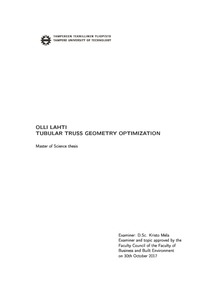Tubular Truss Geometry Optimization
Lahti, Olli Pekka (2017)
Lahti, Olli Pekka
2017
Rakennustekniikka
Talouden ja rakentamisen tiedekunta - Faculty of Business and Built Environment
This publication is copyrighted. You may download, display and print it for Your own personal use. Commercial use is prohibited.
Hyväksymispäivämäärä
2017-12-07
Julkaisun pysyvä osoite on
https://urn.fi/URN:NBN:fi:tty-201711222232
https://urn.fi/URN:NBN:fi:tty-201711222232
Tiivistelmä
In this study, geometry optimization of tubular roof trusses is investigated. Applicable Eurocode 3 design conditions are presented, which provide the constraints for the problem. Optimized roof truss types are typical, statically determinate lattice structures. Member cross-sections are selected from a discrete set of commercially available profiles.
Mixed integer nonlinear programming problem is obtained. Implicit programming approach is utilized to treat the problem, which is divided into two levels. Sizing problem represents the first level problem which is formulated into the mixed-integer linear programming task. Problem is solved utilizing branch-and-cut algorithm. Geometry optimization represents second level problem which is solved utilizing heuristic algorithm. Output of the optimization process is nodal coordinates and member profiles.
Purpose of the work is to facilitate the implementation of geometry optimization in a design tool. The aim of the optimization is to find a light design. Other goal is to study various procedures to decrease calculation time. Procedures are presented on numerical calculations. A closer look is given at a case study to highlight the crucial factors on geometry optimization.
Mixed integer nonlinear programming problem is obtained. Implicit programming approach is utilized to treat the problem, which is divided into two levels. Sizing problem represents the first level problem which is formulated into the mixed-integer linear programming task. Problem is solved utilizing branch-and-cut algorithm. Geometry optimization represents second level problem which is solved utilizing heuristic algorithm. Output of the optimization process is nodal coordinates and member profiles.
Purpose of the work is to facilitate the implementation of geometry optimization in a design tool. The aim of the optimization is to find a light design. Other goal is to study various procedures to decrease calculation time. Procedures are presented on numerical calculations. A closer look is given at a case study to highlight the crucial factors on geometry optimization.
